If you're looking for things to do at the Hawaii Volcanoes National Park (HAVO), we've got you covered with over 60 activities at this world-renowned national park. HAVO is one of the most popular attractions on the Big Island and it’s easy to understand why. With over 300,000 acres under their care, this national park managed by NPS is an outdoor adventurer’s paradise with a mix of Hawaiian folklore and geologic wonders.
Volcanoes are the main attraction here, but there’s actually way more to do at Hawaii Volcanoes National Park. Keep a lookout for unique Hawaiian plants and animals, lava tubes, pit craters, hikes, sea arches and even cinder cones. There’s plenty to do and see for all ages from road tours to backcountry hikes - the difficult part is choosing where you’ll explore first!
CLICK HERE for our Hawaii Volcanoes National Park guide.
1. KÄ«lauea Visitor Center
If there’s one spot you need to include in your Hawaii Volcanoes National Park itinerary, it’s the KÄ«lauea Visitor Center. There’s plenty of information, maps and guidebooks to keep you busy, but most importantly are the NPS staff who will have the most up-to-date information for you about the park. This includes viewable lava flows, current dangers, changes on any of the hikes, and anything else you need to be aware of as you explore the park.
The visitor center is also the souvenir shop should you wish to have a memento of your visit. The store is managed by the Hawaii Pacific Parks nonprofit organization, which supports many of Hawaii’s historical parks.
 KÄ«lauea Visitor Center Exhibits. Hawaii Volcanoes National Park via Flickr
KÄ«lauea Visitor Center Exhibits. Hawaii Volcanoes National Park via Flickr
CLICK TO SHOP for information and souvenirs from Hawaii Volcanoes National Park.
Kilauea Visitor Center
1 Crater Rim Drive
Volcano, HI 96875
(808) 985-6000
2. Crater Rim Drive Tour
Take a unique self-guided tour along Crater Rim Drive and see Hawaiian cultural sites, amazing vistas, steam vents, sulfur crystals, lava tubes and pit craters lining the KÄ«lauea Caldera. It’s easiest to start your Crater Rim Drive Tour from the KÄ«lauea Visitor Center and work your way clockwise. The drive itself without stopping should take you about 45 minutes round trip, but if you plan on doing some sightseeing, the excursion will take you about 2 hours.
Crater Rim Drive Tour highlights:
- UÄ“kahuna (Hawaiian ritual and cultural site)
- KÄ«lauea Overlook
- Wahinekapu (Steaming Bluff)
- Haʻakulamanu (Sulphur Banks)
- KÄ«lauea Iki Overlook
- NÄhuku (Thurston Lava Tube)
- Puʻpuaʻi Overlook
- KeanakÄkoÊ»i Crater
3. Crater Rim Trail
If you’re in for an easy to moderate hike, the Crater Rim Trail is an exceptional one to get started on. It’s accessible from several locations along Crater Rim Drive and the trail is well maintained and relatively flat. If you prefer not missing the sights and exploring the KÄ«lauea caldera on foot, this is a fantastic trail to hike.
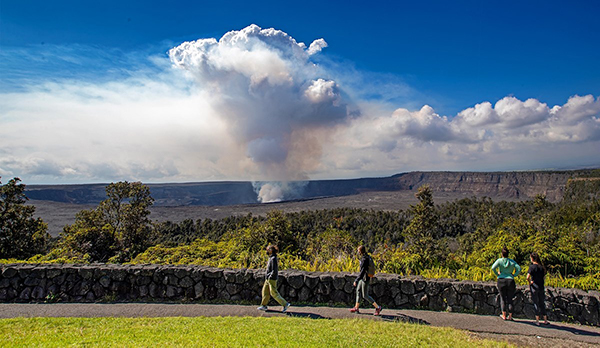 Crater Rim Trail behind Volcano House (NPS Photo/J. Wei)
Crater Rim Trail behind Volcano House (NPS Photo/J. Wei)
4. Chain of Craters Road Tour
Connected to Crater Rim Drive is Chain of Craters Road, which takes you down south all the way to the ocean. The drive is a gorgeous one that includes amazing hikes, cultural and historical sites and lava fields to see along the way. The drive round trip will take you about 2 hours without stopping, but it’s highly recommended that you get out and explore - which can take you anywhere from 4 hours to the rest of the day!
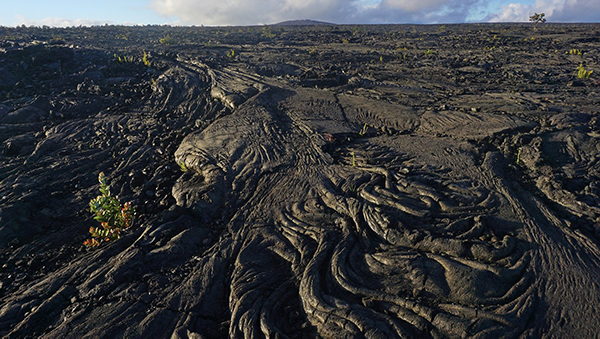 Mau Loa o Mauna Ulu along Chain of Craters Road. NPS Photo/A. LaValle. Public Domain.
Mau Loa o Mauna Ulu along Chain of Craters Road. NPS Photo/A. LaValle. Public Domain.
Chain of Craters Road highlights:
- Luamanu and July 1974 lava flow
- Puhimau Crater
- Pauahi Crater
- Puʻuhuluhulu Cinder Cone
- Mau Loa o Maunaulu (Lava field)
- Kealakomo Overlook
- Alanui Kahiko (Old Chain of Craters Road)
- Puʻuloa Petroglyphs
- HÅlei Sea Arch
5. KÄ«lauea Overlook
Make a stop at the KÄ«lauea Overlook for an unadulterated view of the KÄ«lauea caldera and HalemaÊ»umaÊ»u crater. It’s worth a second look if you were here before 2018 as the latest eruption has dramatically changed the view.
6. Wahinekapu (Steaming Bluff)
As water seeps naturally into the ground, the hot magma heats up the water forming steam which is visible as it floats up. Park at the steam vents area to see this unique scene of nature.
7. Haʻakulamanu (Sulphur Banks)
Want to smell some rotten eggs? The Sulphur Banks on the Crater Rim Trail is a short day hike where sulfur dioxide and hydrogen sulfide are emitted in the form of volcanic gas. It’s a neat chemical reaction to witness and the ancient Hawaiians believed that the pure yellow sulfur was the waste from Pele - Goddess of fire and volcanoes.
LISTEN HERE
8. KÄ«lauea Iki Overlook
If you’re not interested in hiking KÄ«lauea Iki Trail, the overlook gives you an outstanding view of the crater. You’ll also be able to see the PuÊ»upuaÊ»i cinder cone and Mauna Loa in the background.
9. NÄhuku (Thurston Lava Tube)
A very popular stop is NÄhuku or the Thurston Lava Tube. The tunnel is well-maintained and gives you a clear understanding of the power of molten lava. The path is lit during the day, but you’ll need to bring your own flashlight outside of those hours.
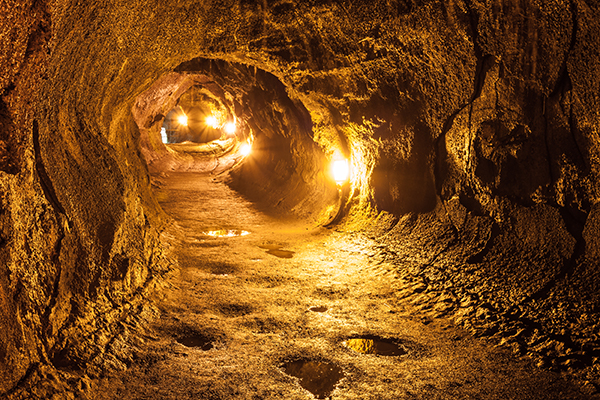
Inside Thurston Lava Tube.
10. Puʻuloa Petroglyphs
One of the coolest things to see on the Chain of Craters Road are the Puʻuloa Petroglyphs. This collection of ancient Hawaiian petroglyphs is the largest in Hawaii and can be reached with just a short hike. The archaeological site boasts over 23,000 manmade images that have been carved into lava rock.
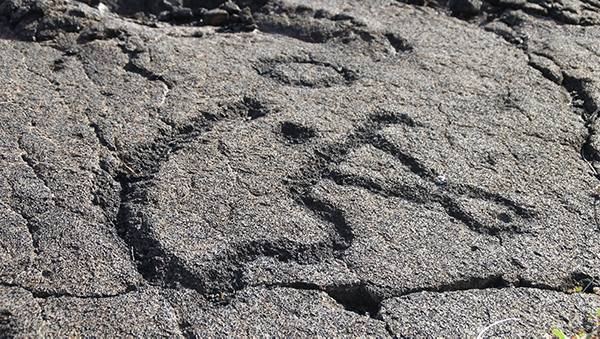
Petroglyphs at Puʻu Loa. NPS Photo, Public Domain.
11. HÅlei Sea Arch
This visual attraction marks the end of the Chain of Craters Road where you can see the HÅlei Sea Arch - a lava formation that was created from lava rock and erosion.
12. Watch Out For Nene Geese
While looking for things to do at Hawaii Volcanoes National Park, you might accidentally stumble upon a sighting of the Hawaiian NÄ“nÄ“ goose. Similar to the Canadian goose, keep an eye out for this endemic bird especially when you’re out driving as they are endangered and protected here in Hawaii. For their safety and to protect their population, please don’t feed them or they’ll learn to approach moving cars.
RELATED: Protect Local Animals - Ways You Can Help
13. Day Hikes
If you only plan on spending one day in Hawaii Volcanoes National Park, 1 or 2 day hikes in your itinerary is a good way to explore and see the sights. The short day hikes include:
- Crater Rim Trail
- Maunaulu
- Puʻuloa Petroglyphs
- KeanakÄkoÊ»i Crater
- Haʻakulamanu (Sulphur Banks)
- Halemaʻumaʻu Trail
- KÄ«lauea Iki
- NÄhuku (Thurston Lava Tube)
- Devastation Trail
- Kūpinaʻi Pali (Waldron Ledge)
- KÄ«pukapuaulu
- Footprints and Maunaiki
- UÄ“aloha (Byron Ledge)
PLAN YOUR HIKES with the Hawaii Volcanoes National Park Itinerary Guide
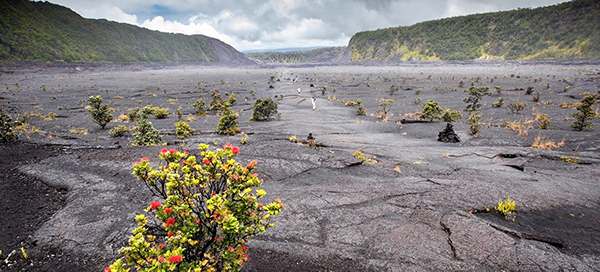 Floor of KÄ«lauea Iki Crater (NPS Photo/J. Wei)
Floor of KÄ«lauea Iki Crater (NPS Photo/J. Wei)
14. Footprints And Maunaiki
An eerie sight is hiking around Maunaiki where you can see the footprints in ash left from native Hawaiians traveling by foot. The eruption occurred in 1790 and it's amazing that we can still see these footprints so precisely more than 2 centuries later.
CLICK TO DISCOVER more amazing stories about Hawaii's volcanoes.
15. Backcountry Hikes
For avid hikers or visitors who enjoy the outdoors, exploring the backcountry hikes is one of the most rewarding things to do at Hawaii Volcanoes National Park. The backcountry hikes include:
- ʻĀpua Point
- Keauhou
- Halapē
- Kaʻaha
- Mauna Loa
- NÄpau
- Pepeiao
RELATED: Know Before You Go For Hawaii Volcanoes National Park
16. The Kahuku Unit
Located about a one-hour drive away from the Kīlauea Visitor Center, the Kahuku Unit was once green pasture land for Hawaiiʻs largest cattle operation on the side of Mauna Loa - the worldʻs largest volcano. There are a number of hikes to enjoy here:
- Pu‘u o Lokuana Cinder Cone
- Pu‘u o Lokuana Trail
- Kamakapa‘a Trail
- Palm Trail
- Pali o Ka‘eo Trail
- Pit Crater Trail
- The Glover Trail
- The Kona Trail
There’s also a souvenir shop at the Kahuku Unit. Click to shop for souvenirs that support the Hawaii Volcanoes National Park.
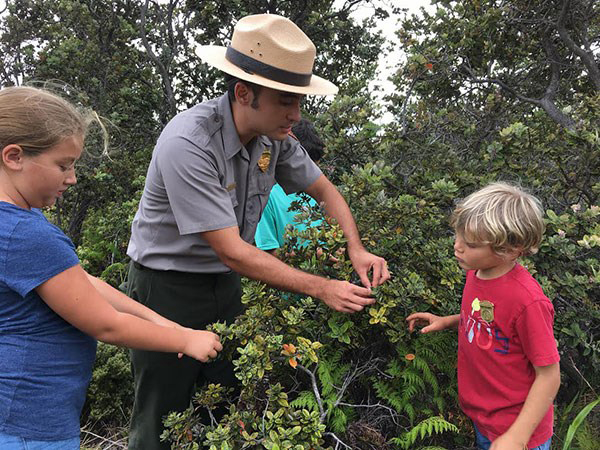 Ranger Noah Gomes explains the importance of ‘Åhi‘a lehua in native forests / NPS/Sierra McDaniel
Ranger Noah Gomes explains the importance of ‘Åhi‘a lehua in native forests / NPS/Sierra McDaniel
17. Shaka Guide Tour
One of the best things to do at Hawaii Volcanoes National Park is to take the Shaka Guide driving tour throughout the park! The tour begins at the entrance to the park and takes you along popular points of interest including the Crater Rim Drive, the Destination Trail, Kilauea Visitor Center and the Kilauea Iki Hike. The tour takes about 4 - 6 hours, but with 45 narration points, don’t be surprised if it goes even longer!
Interested in driving the Hawaii Volcanoes National Park Shaka Guide tour? Download the app today to get started!
18. Biking
If youʻre into bike trails, Hawaii Volcanoes National Park is a great spot to check out. In addition to the bikeable trails and hikes near Crater Rim Drive and Chain of Craters Road, the Kahuku Unit also has a few trails open to biking. All bike-friendly paths welcome e-bikes, too!
19. Volcano House Hotel and Restaurant
Managed by Hawaii Volcanoes Lodge Company, the historic Volcano House sits on the rim of the KÄ«lauea caldera with a beautiful panoramic view of the park. Dine at The Rim and sit next to impressive floor-to-ceiling windows overlooking the caldera, visit the snack bar, take it easy in the lounge and shop for souvenirs at their gift shop.
RELATED: Getting hungry? Here is the best food around Hawaii Volcanoes National Park.
20. Camping
The Hawaii Volcanoes Lodge Company also manages 10 cabins and campsites at the NÄmakanipaio Campground. The Kulanaokuaiki Campground has 9 campsites, but no running water. Enjoy nature, set up your BBQ grill and picnic as you relax for the rest of the day.
21. Weddings (Special-Use Permit)
Did you know you can get married at Hawaii Volcanoes National Park? A special-use permit is required and the wedding must be small (you’re allowed to set up one table with 12 seats), but it’s a memorable spot for tying the knot if you have a personal connection to the area.
22. Scattering of Ashes (Special-Use Permit)
Another ceremony that requires a special-use permit is the scattering of ashes. Like wedding ceremonies, this should also be a small and private affair with a few close friends and family members in order to comply with the NPS rules.
23. Stargazing
Most people don’t realize that Hawaii Volcanoes National Park is actually open 24 hours a day. That means stargazing in the park is beautifully mind blowing. With practically zero light pollution for miles and miles around you, it’s worth revisiting or staying after dark to look up into the night sky. Make sure you visit when there’s no moon to get the maximum effect of the stars and galaxies.
24. Special Programs
Guided hikes and demonstrations are held periodically at the park. The tentative schedule is on the Hawaii Volcanoes National Park website, but it’s best to confirm these times at the KÄ«lauea Visitor Center.
25. Stewardship At The Summit
For those who would rather donate their time and effort while visiting the park, consider joining the Stewardship At The Summit program where you’ll cut down invasive Himalayan ginger while hiking from the KÄ«lauea visitor center.
26. Volunteer Work
If you’re in Hawaii long term and are looking for something constructive to do at Hawaii Volcanoes National Park, there are plenty of positions that you could potentially fill from administrative work to removing invasive plant species on trails.
RELATED: 10 Ways to Be a Safe and Responsible Traveler in Hawaii
27. Volcano Art Center
Love local art? Head to the Volcano Art Center where you’ll find an eclectic collection of local art pieces such as paintings, sculptures and even cultural workshops centered around the art of hula.
28. Junior Ranger HAVO Edition (Virtual)
Some of the best things to do at Hawaii Volcanoes National Park can be done before you even get there! Children will have fun preparing for their visit to the park by completing the accompanying virtual scavenger hunt and Junior Ranger coloring book. It’s a great way to get them excited about Hawaii’s volcanoes and gain some understanding of what they’ll see when they get there.
29. Voices Of Science Podcast (Virtual)
Fans of science will want to bend their ear to the Voices of Science podcast that covers the national parks in Hawaii including Hawaii Volcanoes National Park.
30. Student archaeology programs
Children who have an interest in archaeology or geology will benefit from the Hawaii Volcanoes National Park’s archaeology magazine. The magazine includes kid-friendly activities and helps children see through the eyes of an archaeologist.
31. School Programs
Teachers and field trip chaperones will want to take the opportunity to sign up for a field trip for their group of children. Both virtual and in-person programs are available, so this can even be done from your classroom.
32. See Lava (Conditions Permitting)
While it’s cool seeing hardened black lava rock frozen in waves and ripples, it’s even cooler if you can see it in action! Active lava flows are not always visible, but it does happen and there are several tours and locations you can visit to see it in person.
RELATED: How To See Lava In Hawaii
Like this article? Share it on Pinterest!

Want to discover more about the Big Island? Try one of our Big Island driving tours!
This post was originally published on April 9th, 2019.
RELATED ARTICLES:
Know Before You Go, Shaka Guide's Hawaii Volcanoes National Park Tour
Shaka Guide's Hawaii Volcanoes National Park Tour Itinerary
Hawaii Volcanoes National Park Guide, Updated 2023
Best Food Around Volcanoes National Park On Big Island